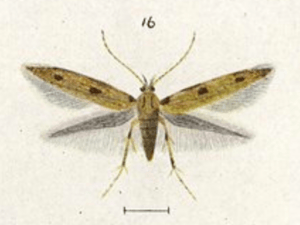Circoxena ditrocha facts for kids
Quick facts for kids Circoxena ditrocha |
|
|---|---|
 |
|
| Scientific classification | |
| Kingdom: | |
| Phylum: | |
| Class: | |
| Order: | |
| Family: |
Blastodacnidae
|
| Genus: |
Circoxena
|
| Species: |
C. ditrocha
|
| Binomial name | |
| Circoxena ditrocha Meyrick, 1916
|
|
Circoxena ditrocha is a species of moth in the family Blastodacnidae. This species is endemic to New Zealand. It is classified as "At Risk, Naturally Uncommon" by the Department of Conservation.
Contents
Taxonomy
This species was first described by Edward Meyrick in 1916 using a specimen collected by George Hudson at Wainuiomata in December. Hudson discussed and illustrated the species in his 1928 publication The butterflies and moths of New Zealand. In 1973 John S. Dugdale discussed the species and illustrated the wing venation as well as the genitalia of both the male and female. The holotype specimen is held at the Natural History Museum, London.
Description
Meyrick described this species as follows:
♀︎. 11 mm. Head dark shining bronze. Palpi and antennae white lined with black. Thorax dark bronzy-fuscous, external edge of patagia white. Abdomen dark grey. Forewings elongate-lanceolate, fuscous, suffusedly streaked longitudinally with blackish ; a fine white longitudinal line just beneath costa on basal fourth, costal edge black ; dorsum white towards base ; a light yellow-ochreous patch occupying basal third of wing from near costa to fold, marked with three fine whitish longitudinal lines diverging from base ; two large fine whitish rings in disc before middle and about 2⁄3 ; a small black apical spot preceded by some whitish suffusion : cilia on costa dark grey, basal half barred with ochreous-whitish, on termen ochreous-whitish tinged with grey towards tips and basal area barred with grey. Hindwings grey, becoming dark grey towards apex : cilia whitish-grey.
Alfred Philpott studied and described the male genitalia of the species in 1927.
Distribution
This species is endemic to New Zealand. It has been found from Auckland to Invercargill.
Biology and behaviour
The adults of this species have been found on the wing in December and March. Hudson noted that C. ditrocha was a sluggish flyer and could be collected by sweeping foliage.
Host plants and habitat
The host plants of the larvae of this moth are unknown, but the larva may be a seed borer. Adults of this species prefer habitat at the edges of forest or scrub and appear to be associated with Pseudopanax arboreus.
Conservation Status
This species has been classified as having the "At Risk, Naturally Uncommon" conservation status under the New Zealand Threat Classification System.
Images for kids



